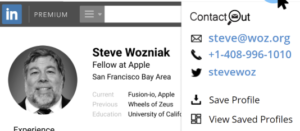The Ad Agency Client Prospect List
 Update 28 March 2019: I am adding ContactOut to my list of tools that can help you find the work email address and phone numbers of your prospects. You know, the prospects that are on your very focussed short list of clients that want to work with you but do not know you exist. Some smart product language from ContactOut:
Update 28 March 2019: I am adding ContactOut to my list of tools that can help you find the work email address and phone numbers of your prospects. You know, the prospects that are on your very focussed short list of clients that want to work with you but do not know you exist. Some smart product language from ContactOut:
ContactOut is a simple browser extension that helps you find email addresses and phone numbers of anyone on LinkedIn. We’ve been around for just over three years and already have thousands of users from a third of the Fortune 500 (like Microsoft, PwC, and Symantec). ContactOut finds emails from 75% of Linkedin users (2x better than the next closest competitor) at a 97% accuracy rate. It’s earned us multiple mentions on the ahrefs blog as one of the best freemium email outreach tools available.
Inbound Marketing Is Nice, But…
I am a card-carrying inbound marketer. Most of my advertising agency clients come to me via my inbound efforts that include some decent SEO, hundreds of informative blog posts and SMM (Social Media Manipulation – take that S&M). This is most likely how you found this website.
However, if your marketing an advertising agency that knows what clients it should have based on its brand position, category experience, and skills, inbound alone won’t do the trick. You will need to employ one or more outbound marketing techniques to directly reach those clients and their decision makers. You’ll do this by creating a list. Yes, a duh. But, a critical duh. I do not agree with the idea that B2B direct marketing is dead. Only DM programs that can and should be ignored are dead.
I loved building client prospect lists for my ad agency. The act of list building focused our business development objectives and strategies and provided a very clear trajectory for our outbound and inbound marketing programs. I view the art and science of database building to be a critical element of business development.
I recommend that my advertising agency clients develop a top 25 to 50 company/owner/marketing director business development ‘A’ list. These are those special clients that will be directly and personally targeted via a customized thought-leadership sales program. You will have to go well past cold calling to warm calling to entice these marketers to listen to your message.
At the same time, build a longer list (250 – 1,000) for less intensive outreach via somewhat automated marketing tools like your email program. This list is designed to keep you top-of-mind within a much broader set. Note: My regional agency Citrus had a monthly mailing list of well over 1,500. One of the key values of this large list was that we knew that we needed to stay top-of-mind within a very large group of people who know people. Any of these might wake up needing a new agency. Be active, not too passive.
Prospect List Building Criteria – From Macro To Micro
Establish your ‘A’ list using strategic and realistic client prospect criteria. In the past, I have used the following criteria to build lists for my agency. Of course, your criteria might be different.
First, include any prospects that you already know or you know you from existing lists including your email list (a key reason to have an active blog); past events (like what you should do with all of those collected business cards) and your very own LinkedIn, Twitter and Facebook Followers.
Secondly, make a list of all of the clients in your target categories (specific business categories to geographic fit) that currently use competitive agencies. Obvious? Sure. But, you’d be surprised at how few agencies keep this client opportunity list fresh.
Decision-Making Criteria – You Want to get to “Yes.”
Here is a list of primary criteria questions for that ‘A’ list. If the answer is a big ‘no’ you might not want to waste your time with this client.
- Is the client in one of our targeted business categories?
- Is there a geographic fit?
- Do they have market issues like low brand share we can address?
- Does the client spend on and respect marketing?
- Can we find problems to address in their current communications program?
- Can our agency develop a compelling sales message?
- Does our agency have any direct competitive conflict? If so, can we overcome this small issue?
- Have we worked on any client issues, regardless of category, that are shared by the prospect?
- Is there a technology solution we have or used they should be using?
- Does the client appear willing to leave their agency or assign a side project?
- Might project work for this client lead to additional work in their company – or beyond?
Consider creating a quantitive rating/scoring system to rank the client opportunities based on your business objectives and history. Be realistic.
The Big 4
To further simplify the process, our agency asked if our prospects met at least 2 our 4 major client requirements? We liked to have 2 but any 1 of these alone might have put the client on our primary list. Our client Nike met all 4.
- Are they a famous brand that might create incremental awareness for the agency?
- Do they value marketing?
- Does the client have the budget to support the right programs and can they be profitable?
- Do they have a history of partnering on great ‘creative’ work?
OK, one more. Do they appear to be fun to work with? We didn’t go after clients with very bad reputations.
Getting To Individuals
 Now that you have a list of companies, it’s time to find the right individuals to target. Review your ‘people’ list every 6 months – people move.
Now that you have a list of companies, it’s time to find the right individuals to target. Review your ‘people’ list every 6 months – people move.
Build individual prospect lists using:
- Google and Bing. Both.
- Corporate websites and social media.
- Mine the personal or business contacts of everyone at your agency.
- Lists of competitive agency clients – read the agency’s News and Client and Work sections.
- Paid database services including Access Confidential, The List Inc. and the Redbook.
- Category-specific databases and lists. Relevant marketing associations and their membership are a good starting point.
- The trade press (advertising and brand category press) for ideas. In fact, go back a couple of years to when the client selected his current agency. He’s probably tired of them now.
- Events and networking. Speak at industry (your prospect’s industries) if you can. Bring those business cards.
Occasionally, OK more than occasionally, building your list will require a pick and shovel. Hand-build the list via outsourced low-cost services like UpWork or local interns.
‘Who-Is’ Tools
To help build the lists and find out how to reach the decision makers, I use a range of information tools. There is a wide range – here is a short-list.
OK, start simple… Perform a Google, Bing or Twitter search to find someone’s email address, i.e. “Peter Levitan Email”.
Set up Google Alerts for target clients.
Use the Datanyze Insider Chrome extension to find the right email address for a given prospect. You’ll love this one. It also works with LinkedIn to find a non-personal-contact prospect’s email address.
As mentioned above, try ContactOut to find those LinkedIn secrets.
Twitonomy. Use Twitter as a competitive wrench. As Twitonomy says, “Get detailed and visual analytics on anyone’s tweets, retweets, replies, mentions, hashtags… Browse, search, filter and get insights on the people you follow and those who follow you.” Damn, go forth and use your competitor’s data!
Socialmention focuses on blogs, video, and social media. You enter a search term, either a keyword or a company, and the tool will tell you what’s being said about that term across blogs and social platforms. Often, senior client’s are mentioned in the articles.
AdForum lists many agency’s clients.
LinkedIn. Yes, another obvious. Spend the bucks to get a Premium Professional account and you’ll be able to do a deeper search of the LinkedIn database. Once you are in, you’ll love using Datanyze to find the business email addresses of even those LinkedIn members that you are not connected to.
More Thinking To Grow Your Agency.
By the way, here is a link to an article that will help you figure out that you should be ‘advertising’ to your prospects. Yes, advertising.

Leave a Reply